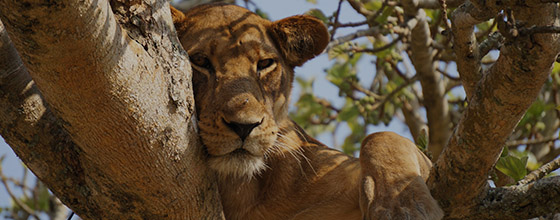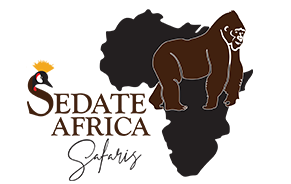
Uganda Savannah wildlife | Uganda wildlife tours | Uganda safaris
The 1978km2 Queen Elizabeth National Park is one of Uganda’s oldest protected areas. Originally gazetted as the Lake George and Lake Edward game reserves in 1925, it was upgraded to create one of Uganda’s first national parks in 1952. Queen Elizabeth lies directly on the equator. A pair of concrete hoops marks the spot where the 0O line crosses the Kasese road.
The park is home to over 95 mammal species and over 600 bird species. The park’s highest point, 1,350m above sea level, is found in the Katwe Explosion Craters while the lowest point is 910m on the shore of Lake Edward. Scenic and biodiverse, Queen Elizabeth National Park (QENP) is Uganda’s most popular protected area. Diverse ecosystems, including sprawling savanna, shady forests, sparkling lakes and lush wetlands, provide ideal habitats for classic big game, forest primates, and birds.
An abundance of magnificent vistas include the jagged backdrop of the Rwenzori Mountains; rolling hills pocked with extinct volcanic craters; open, rift valley grasslands at Kasenyi and Ishasha; the hippo-lined Kazinga Channel; and the Mitumbe mountains in Congo rising above the distant, western shore of Lake Edward Queen Elizabeth National Park and its surroundings are also of cultural and historical interest. There are many opportunities for visitors to meet the local communities and enjoy storytelling, dance, music and more. The park was initially named Kazinga National Park in 1952, but was renamed two years later to commemorate a visit by Queen Elizabeth II.
WILDLIFE
QENP’s various habitats support a wealth of wildlife with more mammal species (95) than any other Ugandan park and over 600 bird species – a phenomenal number for such a small area. Expect to see safari favourites such as elephants, buffaloes and hippos. The chances of finding lions on the plains of Kasenyi and Ishasha are good, especially with a ranger guide, while leopard sightings are frequent, though unpredictable, around Mweya and the nearby Channel Track.
Classified as an Important Birding Area by Birding International, QENP is a superbly varied destination for birdwatchers with species representing the park’s varied habitats. Its location at the overlap of East African savanna and Congo forest also means that species from both biomes are present.
Local People
Bunyaruguru people live on the Kichwamba Escarpment to the southeast of QENP. The area to the north of the park is the home of Basongora pastoralists while Bakonzo farmers cultivate the slopes of the Rwenzori mountain beyond. ACCESS Roads Two routes run from Kampala to Mweya, the primary tourism hub in QENP. The most scenic route passes through Fort Portal (410km) and offers detours to Kibale, Semuliki and Rwenzori Mountains national parks. The alternative (420km) runs through Mbarara and Bushenyi and passes Lake Mburo National Park. QENP’s southerly Ishasha sector is directly on the main route to/from from Buhoma, the main mountain gorilla tracking trailhead in Bwindi Impenetrable National Park, which lies 62km south. Air Charter flights can be arranged to airstrips at Kasese, Mweya and Ishasha.
Climate
Daytime temperatures average 18-280C. Nights can be cool.
When to Visit
All year round
Mweya peninsula and the kazinga channel
QENP’s main tourism hub is found on Mweya Peninsula, 22km west of the Kasese-Mbarara Road. Mweya, which occupies an elevated plateau overlooking the Kazinga Channel and Lake Edward, is the site of an upmarket lodge; budget UWA run accommodation; a marina for launch trips on the channel; and a Visitor Information Centre. Activities are booked at the latter facility which also contains exhibits relating to the park and its rift valley setting.
Launch cruises
Launch trips on the Kazinga Channel provide the most relaxing way to view game in Queen Elizabeth National Park. The 2-hour return voyage between Mweya and the channel’s entrance into Lake Edward cruises beside banks lined with resident hippos, crocodiles and waterbirds and visiting elephant, buffalo and antelopes.
Game Drives
Kasenyi plains
Half an hour’s drive from Mweya, the open grasslands of Kasenyi provides the primary game viewing area in central QENP, thanks to the resident herds of Uganda kob and the lions that prey on them. Kasenyi’s experienced ranger guides can usually locate lions but predator sightings can be guaranteed by signing up for a tour with the Mweya-based Uganda Predator Project which monitors the movement of lions, leopards and hyenas fitted with radio collars.
Ishasha
Conveniently located on the road to Bwindi Impenetrable National Park, QENP’s southernmost sector offers a classic game viewing experience under vast rift valley skies. Expect to see buffaloes, hippos, elephants, topis and more besides. The chance of sighting lions is particularly good in Ishasha; the local prides obligingly spend their days resting up in the branches of shady fig trees.
Forest Walks
Kyambura Gorge
The forest-filled Kyambura Gorge extends from the Kichwamba Escarpment to the Kazinga Channel. Enjoy the giddy viewpoint on the edge of the 100m-deep chasm before descending into the depths to track chimpanzees with UWA guides.
Maramagambo Forest
At the foot of the Kichwamba Escarpment, the shady Maramagambo Forest contrasts with the park’s open grasslands. Guided walks afford sightings of primates and rare birds (including the forest flycatcher, whitenaped pigeon and the striking Rwenzori turaco) and visit Lake Nyamusingire (home to the African finfoot, this is formed by three connected crater lakes), the copperrich Blue Lake and the Bat Cave with its resident batgorged python.
Birding
Birding activities overlap with the wildlife viewing locations described above. Highlights include easy sightings of resident and migratory waterbirds on the Kazinga Channel; spectacular seasonal congregations of flamingoes on the Kyambura and Katwe soda lakes; careful searches for rare and restricted range forest species in Maramagambo Forest; and memorable shoebill sightings on the remote Lake Edward Flats in Ishasha.
Volcanic Explosion Craters
Crater Drive
Dozens of volcanic craters pock the landscape north of Mweya to remind us of the Albertine Rift’s violent tectonic history. The 27km Crater Drive between the Kabatoro and Crater gates follows a breathtaking route around the rims of extinct craters filled, variously, with lakes, forest and grassland. The Queen’s Pavilion, at the Crater Gate on the eastern edge of the crater area, has been visited three times by British royalty. A small information centre and coffee shop stands on the site. The equator markers straddling the adjacent Kasese highway provide a popular photo opportunity.
Katwe Salt Lake
The people of Katwe town, 12km from Mweya, have been extracting salt from the saline Lake Katwe using evaporation pans since the 14th century. Local guides will escort visitors down into the crater to see the process. The adjacent Lake Munyanyange is rich in waterbirds, including migrating lesser flamingo between August and November.
Kyambura Wildlife Reserve
This small reserve to the east of Kyambura Gorge is dotted with crater lakes that are visited, seasonally, by greater and lesser flamingoes.
